Here you'll find a set of pictures I've taken myself featuring calculators and pocket computers of diverse brands (other than HP or SHARP) selected from my own personal collection, as well as useful details and my (hopefully interesting) anecdotes and comments on each particular model, including links to relevant materials (Articles, Brochures, Challenges) previously uploaded by me to this very site. Enjoy!
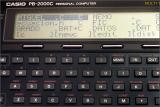
The CASIO PB-2000C is one of the rarest pocket computers, a multi-language one that included a buit-in standard (K&R) C interpreter but would accept ROM modules for programming in BASIC and Pascal, among others (Prolog, CASL, ...). It has 32 Kb of RAM (expandable via RAM card to 64 Kb) as well as a dot-matrix LCD display (4x32 char, 32x192 px), in a somewhat large, heavy unit.
Regrettably, although C is usually associated with low-level access and speed, the interpreter here (and the precompiler which compiles to P-code) is quite slow, certainly slower than both my SHARP PC-E500 or my HP42S, to name a few, and the unavoidable compilation process causes a somewhat annoying delay before the program you just entered starts to run. Gaining speed by directly accessing RAM or calling assembler routines in the ROM or external should be possible but if that's the case there's no documentation that I know of on how to proceed.
On the positive side, it admits a number of peripherals including printing, plotting, storing to tape and floppy. and RS-232 Centronics inteface, which is nice and offers lots of possibilities.
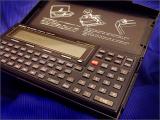
The CASIO PB-2000C is one of the rarest pocket computers, a multi-language one that included a buit-in standard (K&R) C interpreter.
See the full description and other details in the link above this one.

The CASIO PB-2000C is one of the rarest pocket computers, a multi-language one that included a buit-in standard (K&R) C interpreter.
See the full description and other details in the links above this one.
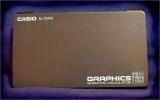
This is my CASIO fx-7500G, a most awesome scientific programmable graphic calculator released in 1989. To begin with, it's extremely small, a 140-gram version of the CASIO fx-7000G but with a foldable design which fits most any pocket and about 6 times more RAM (4 Kb), which provides for 26 fixed memories and 4,006 program steps, convertible to up to 500 additional memories for a gran total of 526 memories. Its dual keyboards house 59 keys, and it features 96x64 dot-addressable graphics displayed in a monochromatic LCD screen. It runs on 3 CR-2025 cells which provide about 2 months of typical use (0.06 W).
The function set consists of 195 functions including hyperbolics, factorial, decimal-sexagesimal conversions, binary-octal-hexadecimal conversions and arithmetic, coordinate transformations, random numbers, full statistics with means and standard deviations, linear regression with correlation coefficient and estimations, all of them computed internally with 13-digit mantissas and capable of holding up to 8 pending operands and 20 pending operations while evaluating expressions. As for the graphic capabilites, it supports 20 types of built-in function graphs plus user-generated functions and statistical graphs (bar and line graphs, normal distribution, linear regressions, etc). It can also read back the coordinates at any selected point.
To top it all, it comes with a big, excellent manual which covers about everything in comprehensive detail and includes a number of useful programs for it, including graphics ones and even blank sheets for your own programs. Finally, it's very fast, about 4 times faster than the HP-71B or the HP-42S and, on the programming side, its decent programming capabilities (which includes labels, indirection, loops, 9 levels of subroutines and up to 10 program spaces with edition and debugging capabilities) and 4-line alphanumeric screen make it easy to write non-trivial programs on it, such as the 31-step Mandelbrot-rendering program you can find in the web. All in all, a real jewel.
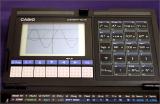
This is my CASIO fx-7500G, a most awesome scientific programmable graphic calculator released in 1989.
See the full description and other details in the link above this one.
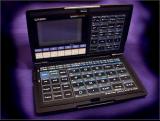
This is my CASIO fx-7500G, a most awesome scientific programmable graphic calculator released in 1989.
See the full description and other details in the links above this one.

This is the Owner's Manual for my CASIO fx-7500G, a most awesome scientific programmable graphic calculator released in 1989.
See the full description and other details in the links above this one.
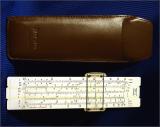
This is my beautiful ARISTO STUDIO 868 slide rule, made in Germany by ARISTO (a main worldwide slide rule manufacturer which stayed in business for 106 years but finally wrapped in 1978), which I bought back in 1973, several years before I acquired my first electronic calculator. It belongs to the renowned STUDIO series, this is the "pocket" version, just 12.5 cm. long (~5 in.) so that you could carry it comfortably with you at all times. It has 22 scales (see the next images), multiple hairlines (PS, KW) in the cursor, and was delivered in a nice leather slip case, also pictured here. Its manual was a 36-page foldable booklet which included the essentials.
The STUDIO series was very successful and thus extensively and unashamedly copied, down to the name itself. Its production ceased only when ARISTO itself closed in 1978. My 868, depicted here, is 46-year old as of 2019 and it's still mint, as new, and looks and works perfectly. Actually, I used it very little because the kind of math work I used to do at the time required much more than the 3-4 digits this model could provide and further shortly after buying it I saw for the first time in my life an electronic calculator in action at my school (a Texas Instruments Datamath) delivering 8-digit results instantly and chaining calculations effortlessly, including additions and subtractions, which a slide rule can't properly do, so I immediately longed for one (though I eventually got a much superior HP-25 instead). Still, this slide rule is a very fine instruments and I'm proud to own one.

This is my beautiful ARISTO STUDIO 868 slide rule which I bought back in 1973. The scales depicted in this image are: T (tan), ST (arc), DF, CF (Pi*x), CIF (1/(Pi*x), CI (1/x), C, D (basic), P (Sqrt(1-x2)), S (sin, cos).
See the full description and other details in the links above this one.

This is my beautiful ARISTO STUDIO 868 slide rule which I bought back in 1973. The scales depicted in this image are: LL01, LL02, LL03 (natural logs), A, B (squares), L (base-10 logs), K (cubes), C, D (basic), LL3, LL2, LL1 (exponentials).
See the full description and other details in the links above this one.
COPYRIGHT NOTICE
These articles, programs, pictures, their descriptions and other materials created by me
are (c) Valentin Albillo, and can be used freely for non-profit purposes
as long as (1) the contents aren't modified in any way and (2) the copyright is acknowledged.
In plain words, you can download them and use them for non-profit purposes but do not include
them in any media and/or site for which you're asking money, do not tamper with their contents and
do not say or imply that you created them or that you don't know who created them, you must
always give due credit to me.